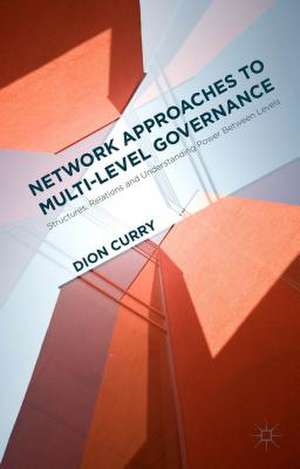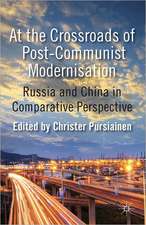Network Approaches to Multi-Level Governance: Structures, Relations and Understanding Power Between Levels
Autor Dion Curryen Limba Engleză Hardback – 9 sep 2015
Preț: 388.13 lei
Nou
Puncte Express: 582
Preț estimativ în valută:
74.27€ • 77.55$ • 61.33£
74.27€ • 77.55$ • 61.33£
Carte tipărită la comandă
Livrare economică 15-29 aprilie
Preluare comenzi: 021 569.72.76
Specificații
ISBN-13: 9781137295170
ISBN-10: 1137295171
Pagini: 224
Ilustrații: 224 p.
Dimensiuni: 138 x 138 x 14 mm
Greutate: 0.42 kg
Ediția:1st ed. 2015
Editura: Palgrave Macmillan UK
Colecția Palgrave Macmillan
Locul publicării:London, United Kingdom
ISBN-10: 1137295171
Pagini: 224
Ilustrații: 224 p.
Dimensiuni: 138 x 138 x 14 mm
Greutate: 0.42 kg
Ediția:1st ed. 2015
Editura: Palgrave Macmillan UK
Colecția Palgrave Macmillan
Locul publicării:London, United Kingdom
Recenzii
'Like Deil Wright's classic 1978 Understanding Intergovernmental Relations, Dion Curry's Network Approaches to Multi-Level Governance makes a significant contribution to understanding the shift from Intergovernmental Relations to Multi-Level Governance. He does so by drawing on a rich range of comparative settings and experiences. It is a book which like Wright's will stand the test of time. It is nuanced, insightful and a must for any MLG library.'
Patrick J. Smith, Director, Institute of Governance Studies/Professor of Political Science, Simon Fraser University, Vancouver, British Columbia, Canada
'Although the concept of multi-level governance has emerged as a central feature of the social and political sciences in recent years, few studies have examined how politics shapes governance with the precision offered by Dion Curry. The fact that this is achieved while making the concept travel beyond the European Union is a remarkable achievement.'
Matthew Flinders, Professor of Politics/Director of the Crick Centre for the Public Understanding of Politics, University of Sheffield , UK
'It can be frustrating to see a literature on comparative politics dominated by a focus on formal institutions. In policy studies, the aim is to focus on more fluid processes. Curry's focus on multi-level governance, when comparing Scottish and British Columbian policymaking, is therefore a welcome addition to policy scholarship. Further, Curry subjects MLG to critical analysis to make sure that this focus on a messy policy process does not come at the expense of conceptual clarity.'
Paul Cairney, Professor of Politics and Public Policy, University of Stirling, UK
Patrick J. Smith, Director, Institute of Governance Studies/Professor of Political Science, Simon Fraser University, Vancouver, British Columbia, Canada
'Although the concept of multi-level governance has emerged as a central feature of the social and political sciences in recent years, few studies have examined how politics shapes governance with the precision offered by Dion Curry. The fact that this is achieved while making the concept travel beyond the European Union is a remarkable achievement.'
Matthew Flinders, Professor of Politics/Director of the Crick Centre for the Public Understanding of Politics, University of Sheffield , UK
'It can be frustrating to see a literature on comparative politics dominated by a focus on formal institutions. In policy studies, the aim is to focus on more fluid processes. Curry's focus on multi-level governance, when comparing Scottish and British Columbian policymaking, is therefore a welcome addition to policy scholarship. Further, Curry subjects MLG to critical analysis to make sure that this focus on a messy policy process does not come at the expense of conceptual clarity.'
Paul Cairney, Professor of Politics and Public Policy, University of Stirling, UK
Notă biografică
Dion Curry is Lecturer in Public Policy at Swansea University. He is interested in multi-level governance and issues of accountability and legitimacy in governance processes. His next project, funded through a Marie Curie EU research grant, focuses on how EU-level governance processes are legitimated at the member state level.
Cuprins
List of Tables and Figures
Preface
List of Abbreviations and Acronyms
PART I: INTRODUCTION
a.Why this matters
b.How this matters
c.Research questions and focus
d.Why this matters
e.Structure of the book
PART II: GOVERNANCE THROUGH THE LOOKING GLASS
a.Governance structures: The base of power
b.Governance networks and relations: The form of power
i.Network analysis
ii.Policy networks
iii.Network governance
c.Multi-level governance
i.Types of multi-level governance
ii.Critiques of multi-level governance
d.Conceptual stretching or a more nuanced understanding? Moving from organising perspective to theoretical framework
e.A new framework for multi-level governance
f.Bringing power and legitimacy into the multi-level governance equation
g.Discussion
PART III: MULTI-LEVEL GOVERNANCE: ANALYSIS IN PRACTICE
a.The policy cycle
b.A bottom-up approach to governance
i.MLG from a bottom-up perspective
c.What case studies can tell us
d.What we can learn from Canada and British Columbia
e.What we can learn from the United Kingdom and Scotland
f.Discussion
PART IV: STRUCTURAL ARRANGEMENTS: THE LOGIC OF RESPONSIVENESS
a.Jurisdictional/legislative arrangements
i.British Columbia
ii.Scotland
iii.Jurisdictional/legislative arrangements in comparison
b.Operational rigidity
i.British Columbia
ii.Scotland
iii.Operational rigidity in comparison
c.Disintermediation
i.British Columbia
ii.Scotland
iii.Disintermediation in comparison
d.Financial capacity
i.British Columbia
ii.Scotland
iii.Financial capacity in comparison
e.Discussion
PART V: RELATIONAL ARRANGEMENTS: THE LOGIC OF CONTROL
a.Policy-specific relations
i.British Columbia
ii.Scotland
iii.Policy-specific relations in comparison
b.General-purpose relations
i.British Columbia
ii.Scotland
iii.General-purpose relations in comparison
c.Contextual factors
i.British Columbia
ii.Scotland
iii.Context in comparison
d.The politics of it all
i.British Columbia
ii.Scotland
iii.Politics in comparison
e.Discussion
PART VI: TOWARDS A NEW UNDERSTANDING OF MULTI-LEVEL GOVERNANCE IN PRACTICE
a.Structural processes
i.Jurisdictional/legislative arrangements
ii.Operational rigidity
iii.Disintermediation
iv.Financial capacity
v.General comments
b.Relational processes
i.Policy-specific relations
ii.General-purpose relations
iii.Context
iv.The politics of it all
v.General comments
c.Connecting theory with reality - The British Columbia case
d.Connecting theory with reality - The Scottish case
e.BC and Scotland in Comparison
f.Discussion
PART VII: CONCLUSIONS
Index
Preface
List of Abbreviations and Acronyms
PART I: INTRODUCTION
a.Why this matters
b.How this matters
c.Research questions and focus
d.Why this matters
e.Structure of the book
PART II: GOVERNANCE THROUGH THE LOOKING GLASS
a.Governance structures: The base of power
b.Governance networks and relations: The form of power
i.Network analysis
ii.Policy networks
iii.Network governance
c.Multi-level governance
i.Types of multi-level governance
ii.Critiques of multi-level governance
d.Conceptual stretching or a more nuanced understanding? Moving from organising perspective to theoretical framework
e.A new framework for multi-level governance
f.Bringing power and legitimacy into the multi-level governance equation
g.Discussion
PART III: MULTI-LEVEL GOVERNANCE: ANALYSIS IN PRACTICE
a.The policy cycle
b.A bottom-up approach to governance
i.MLG from a bottom-up perspective
c.What case studies can tell us
d.What we can learn from Canada and British Columbia
e.What we can learn from the United Kingdom and Scotland
f.Discussion
PART IV: STRUCTURAL ARRANGEMENTS: THE LOGIC OF RESPONSIVENESS
a.Jurisdictional/legislative arrangements
i.British Columbia
ii.Scotland
iii.Jurisdictional/legislative arrangements in comparison
b.Operational rigidity
i.British Columbia
ii.Scotland
iii.Operational rigidity in comparison
c.Disintermediation
i.British Columbia
ii.Scotland
iii.Disintermediation in comparison
d.Financial capacity
i.British Columbia
ii.Scotland
iii.Financial capacity in comparison
e.Discussion
PART V: RELATIONAL ARRANGEMENTS: THE LOGIC OF CONTROL
a.Policy-specific relations
i.British Columbia
ii.Scotland
iii.Policy-specific relations in comparison
b.General-purpose relations
i.British Columbia
ii.Scotland
iii.General-purpose relations in comparison
c.Contextual factors
i.British Columbia
ii.Scotland
iii.Context in comparison
d.The politics of it all
i.British Columbia
ii.Scotland
iii.Politics in comparison
e.Discussion
PART VI: TOWARDS A NEW UNDERSTANDING OF MULTI-LEVEL GOVERNANCE IN PRACTICE
a.Structural processes
i.Jurisdictional/legislative arrangements
ii.Operational rigidity
iii.Disintermediation
iv.Financial capacity
v.General comments
b.Relational processes
i.Policy-specific relations
ii.General-purpose relations
iii.Context
iv.The politics of it all
v.General comments
c.Connecting theory with reality - The British Columbia case
d.Connecting theory with reality - The Scottish case
e.BC and Scotland in Comparison
f.Discussion
PART VII: CONCLUSIONS
Index













